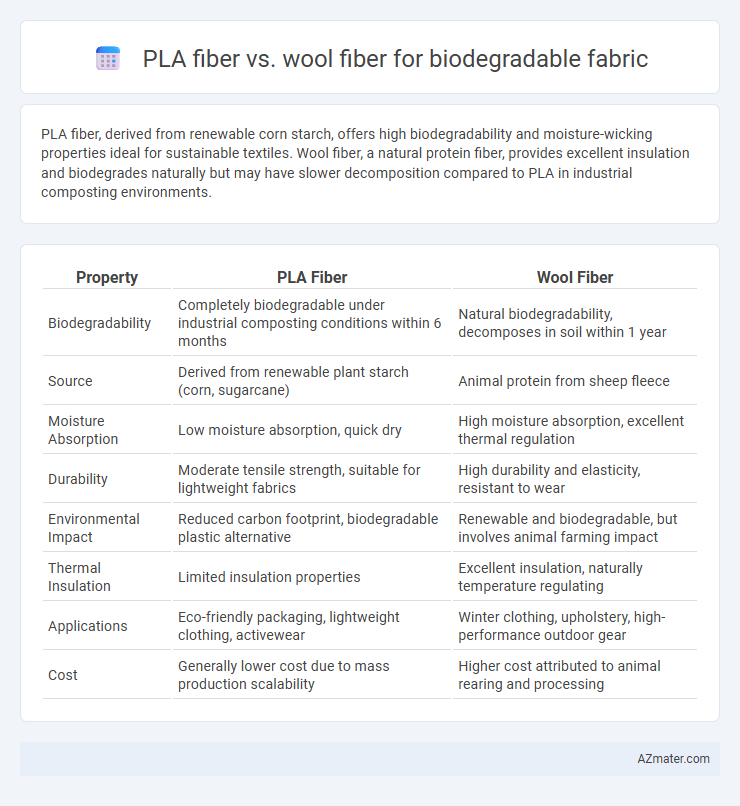PLA fiber, derived from renewable corn starch, offers high biodegradability and moisture-wicking properties ideal for sustainable textiles. Wool fiber, a natural protein fiber, provides excellent insulation and biodegrades naturally but may have slower decomposition compared to PLA in industrial composting environments.
Table of Comparison
| Property | PLA Fiber | Wool Fiber |
|---|---|---|
| Biodegradability | Completely biodegradable under industrial composting conditions within 6 months | Natural biodegradability, decomposes in soil within 1 year |
| Source | Derived from renewable plant starch (corn, sugarcane) | Animal protein from sheep fleece |
| Moisture Absorption | Low moisture absorption, quick dry | High moisture absorption, excellent thermal regulation |
| Durability | Moderate tensile strength, suitable for lightweight fabrics | High durability and elasticity, resistant to wear |
| Environmental Impact | Reduced carbon footprint, biodegradable plastic alternative | Renewable and biodegradable, but involves animal farming impact |
| Thermal Insulation | Limited insulation properties | Excellent insulation, naturally temperature regulating |
| Applications | Eco-friendly packaging, lightweight clothing, activewear | Winter clothing, upholstery, high-performance outdoor gear |
| Cost | Generally lower cost due to mass production scalability | Higher cost attributed to animal rearing and processing |
Introduction to Biodegradable Fabrics
Biodegradable fabrics break down naturally through microbial activity, reducing environmental impact and waste accumulation. PLA fiber, derived from renewable resources like corn starch, offers high biodegradability with compostable properties in industrial conditions. Wool fiber is a natural protein fiber known for its biodegradability, durability, and ability to decompose efficiently in soil, making both fibers sustainable choices for eco-friendly textiles.
Overview of PLA Fiber
PLA fiber, derived from renewable plant-based sources such as corn starch or sugarcane, offers a sustainable alternative to traditional fibers with its biodegradable and compostable properties. Compared to wool fiber, PLA fiber demonstrates higher moisture retention and excellent resilience, making it suitable for eco-friendly textile applications. Its lightweight nature and lower environmental impact during production contribute to its growing popularity in biodegradable fabric markets.
Overview of Wool Fiber
Wool fiber, derived from the fleece of sheep, is a natural protein fiber known for its exceptional biodegradability and renewable nature. Its complex structure allows it to decompose efficiently in soil environments, releasing nutrients that enrich the ecosystem, making it a sustainable choice for eco-friendly textiles. Compared to PLA fiber, which is plant-based and compostable under industrial conditions, wool offers superior environmental benefits due to its minimal chemical processing and inherent biodegradability in natural settings.
Source and Sustainability Comparison
PLA fiber, derived from renewable resources like corn starch or sugarcane, offers a fully biodegradable alternative to conventional synthetic fibers with a lower carbon footprint and reduced water use during cultivation. Wool fiber, sourced from sheep, is naturally biodegradable, renewable, and sustainably harvested when managed with ethical grazing practices, supporting soil health and biodiversity. Compared to wool, PLA production requires less land and pesticides, while wool's ecosystem benefits and durability provide a unique sustainability profile in biodegradable textiles.
Biodegradability and Environmental Impact
PLA fiber, derived from renewable resources like cornstarch, offers excellent biodegradability under industrial composting conditions, decomposing into water and carbon dioxide within months, which significantly reduces landfill burden. Wool fiber, being a natural protein fiber from sheep, biodegrades naturally under various environmental conditions, releasing nitrogen and enriching soil quality, but its degradation is slower compared to PLA. From an environmental impact perspective, PLA production consumes less water and emits fewer greenhouse gases than wool farming, which involves higher land use and methane emissions from livestock, positioning PLA as a more eco-friendly option for biodegradable fabrics.
Mechanical Properties: Strength and Durability
PLA fiber exhibits higher tensile strength and better moisture resistance compared to wool fiber, making it more suitable for applications requiring durability. Wool fiber offers superior elasticity and resilience, providing enhanced flexibility but typically lower abrasion resistance than PLA. Both fibers are biodegradable, yet PLA's synthetic origin often results in more consistent mechanical properties under stress.
Comfort and Wearability
PLA fiber offers a lightweight and moisture-wicking alternative to traditional wool fiber, enhancing comfort in biodegradable fabric applications. Wool fiber excels in insulation and breathability, providing superior temperature regulation and softness for extended wearability. Both fibers contribute to sustainable textiles, with PLA favoring synthetic biodegradability and wool leveraging natural fiber decomposition.
Processing and Manufacturing Differences
PLA fiber, derived from renewable resources like corn starch, undergoes a polymerization process followed by melt spinning, which enables consistent fiber production with lower energy consumption compared to wool. Wool fiber, sourced from sheep, requires scouring, carding, and spinning, involving more water usage and chemical treatments to remove natural oils and impurities. The manufacturing of PLA fibers allows for precise control in fiber morphology and biodegradation rates, whereas wool's natural protein structure imparts inherent biodegradability but with less uniform processing outcomes.
Cost and Market Availability
PLA fiber is generally more cost-effective than wool fiber due to its synthetic production from renewable resources like corn starch, which leads to lower raw material and manufacturing expenses. Wool fiber, being a natural animal product, tends to be more expensive and subject to market fluctuations based on livestock availability and seasonal factors. Market availability of PLA fiber is increasing rapidly with growing demand for sustainable textiles, while wool has a more established but regionally limited supply chain influenced by agricultural conditions.
Conclusion: Choosing Between PLA and Wool Fibers
PLA fiber offers a sustainable, biodegradable alternative derived from renewable resources like corn starch, making it ideal for eco-friendly fabric production. Wool fiber, naturally biodegradable and renewable, provides excellent thermal insulation and durability but may involve higher resource use and animal welfare considerations. Selecting between PLA and wool fibers depends on balancing biodegradability, environmental impact, fabric performance, and ethical preferences in sustainable textile applications.

Infographic: PLA fiber vs Wool fiber for Biodegradable fabric
 azmater.com
azmater.com